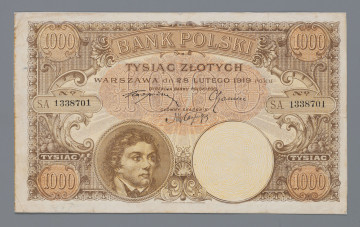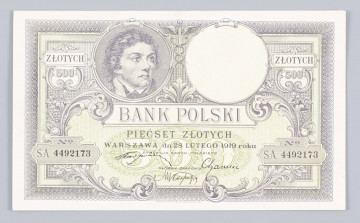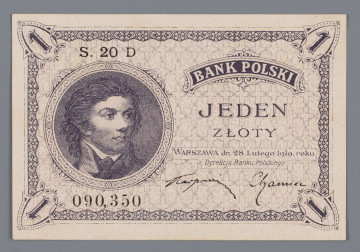
1000 zlotys
1919
National Museum in Lublin
Part of the collection: Paper money during the Second Polish Republic
Poland's regaining of independence in 1918 meant that many state structures had to be built. In the fiscal sphere, one of the first actions was the issuance by the Head of State of a decree of 29 January 1919 on the establishment of the National Treasury Office. Funds for the National Treasury were raised from donations from private individuals, including both precious metals and items made from them as well as currency and securities. These funds were to supply the resources of the future Bank Polski. Exactly a week later another decree appeared, establishing the new currency of the reborn state. The initial name Lech was eventually changed to zlotys, but the decision of 5 February 1919 marked the beginning of the history of the currency of the reborn Poland. Pursuant to the Act of the Sejm of 28 February 1919, the previously adopted assumptions were put into effect. The decision to print zloty banknotes was taken very quickly. The impossibility to carry out this task at home forced the Polish National Loan Bank (Krajowa Kasa Pożyczkowa), which until 1924 played the role of a substitute national bank, to contract the printing of banknotes with foreign printing houses. In the case of the denominations from 100 to 5000 zloty, the choice fell on the London printer Waterlow & Sons. All banknotes printed in London were of a subdued design. Two cartouches were a constant feature of the obverse and reverse. One of them depicted the bust of Tadeusz Kościuszko (left, on the obverse) and the national emblem (right, on the reverse), while the other featured a watermark with an image of the leader of the 1794 uprising.
A characteristic and somewhat unusual feature of the 100-zloty banknote was the decorative frame with drawings of butterflies placed on the edge of the obverse. Apart from the afore-mentioned watermark, the banknotes had security features in the form of a rather intricate background drawing and the serial numbers (S. A., S. B. or S. C.) and seven-digit numbers.
The 100-zloty banknotes were printed in 1,733,740 pieces. Due to the difficult economic situation in the country, the banknotes were stored in warehouses for five years. They were put into circulation on 28 April 1924 and remained there until the second year of the war. They were withdrawn from circulation together with the 500-zloty banknotes on 31 January 1940, with the final exchange date set for 20 April 1940.
Leszek Poniewozik
Author / creator
Dimensions
cały obiekt: height: 170 mm, width: 102 mm
Object type
paper money
Technique
Material
paper
Creation time / dating
Creation / finding place
Owner
The National Museum in Lublin
Identification number
Location / status

1919
National Museum in Lublin

1919
National Museum in Lublin

1919
National Museum in Lublin
DISCOVER this TOPIC
National Museum in Lublin
DISCOVER this PATH
Educational path